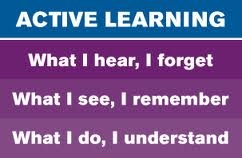High Impact Learning
 Free Learning Resource: Introduction to High Impact Learning
Free Learning Resource: Introduction to High Impact Learning
Learning is Change. Change is Learning.® Today’s competitive advantage goes to those who can learn and adapt faster. High Impact Learning integrates learning, leadership and change management competencies to produce documented, sustainable results.
A hot topic in the learning community is return on investment (ROI). The goal is to provide evidence for changing policies and practices to support investments in people. How do organizations know where to invest their training dollars?
Organizations need to abandon event-based thinking and adapt to performance-based thinking. High Impact Learning does that by encouraging leadership involvement and applying retention strategies that ensure learning is not only an event but a true process that changes behavior and performance. This is achieved by implementing a 3-step process: Align, Assimilate & Apply.
3-step Process: Align, Assimilate & Apply

Alignment Phase
Before participating in a learning event, participants should have a thorough understanding of what they are expected to learn, how their behavior is expected to change, the results they are expected to achieve, and how these results contribute to the overall goals of the organization. To help meet these expectations, the use of learning objectives and Learning Impact Maps are crucial.
Well-developed learning objectives are the foundation of a successful learning intervention. These objectives should be measureable and define the action a participant will be able to take post-training.
A Learning Impact Map is a simple tool used to identify if the training can achieve the desired results, prepare participants to learn and change behavior based on the training, and link the desired behavior with organizational performance and business goals.
Assimilation Phase
During the learning event, the focus is on assimilating the learning that resonates best with the participant. An effective learning event will engage participants to apply what they already know in building relevant skills and knowledge that they can focus on and practice during the class. An effective learning event should be participant-centered, include adult learning principles, be led by effective facilitators and incorporate a learning impact map.

Successful learning events recognize that adults learn differently. They bring a wide range of knowledge, life experiences, interests and competencies to the experience. The following four principles of adult learning should be incorporated into any active learning environment:
- Prior Knowledge
- Relevance
- Active
- Self-Direction
Application Phase
Applying what one has learned is where 80% of learning takes place. The Application phase involves using the skills and knowledge within the work environment that makes the learning stick, causing a behavior change that produces desired results. During this phase the Learning Impact Maps are used to reflect on the original goals and note any new-found knowledge.
Follow-through is an important step in the learning process as it encourages participants to take action, solicit feedback, and continue collaborative learning for up to three months after the learning event.
Results
Training delivers maximum results when a class inspires retention, management is involved, a Learning Impact Map is documented and a follow-through plan is in place. A High Impact Learning program can help you bring these elements together for an educational experience that changes behavior to achieve personal and organizational goals.
For More Information on Training and Services
800-556-9589 | education@LCE.com
